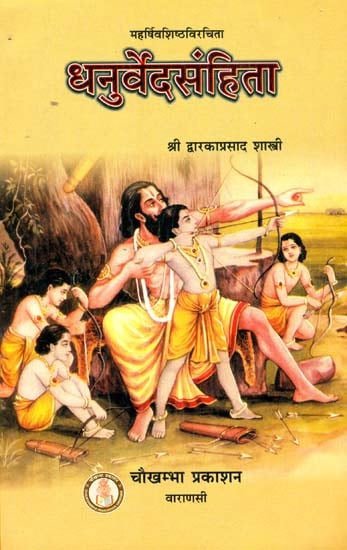Dhanurveda Samhita [sanskrit]
3,015 words
The Sanskrit text of the Dhanurveda-samhita attributed to Vasishtha. Dhanur Veda is a type of ancient India science whose roots date to the 2nd millenium BCE. It is counted among the Upavedas literature. This specific version of the Dhanurveda contains roughly 240 sections of Sanskrit text.
Verse 1.114
अरुणोदयः वेलायां वारिदो यदि गर्जति ।
तद्दिने स्यादनध्यायस्तमकालं प्रचक्षते ॥ ११४ ॥
aruṇodayaḥ velāyāṃ vārido yadi garjati |
taddine syādanadhyāyastamakālaṃ pracakṣate || 114 ||
Note! The following is not a translation of the above verse, but merely an arbitrary extract of the English text.
If the rain roars at the time of the rising of the sun On that day there is no study of the Vedas, and that day is called tama-kala.
English translation by Hardayalu Swami (2001) Buy now!
Glossary of Sanskrit terms
Note: This extracts Sanskrit terms and links to English definitions from the glossary, based on an experimental segmentation of verse (1.114). Some terms could be superfluous while some might not be mentioned. Click on the word to show English definitions.
Arunodaya, Vela, Varida, Yadi, Yad, Garjat, Taddina, Syat, Sya, Anadhyaya, Tamaka, Alam, Ala, Pra,
Analysis of Sanskrit grammar
Note: this is an experimental feature and only shows the first possible analysis of the Sanskrit text (Verse 1.114). If the system was successful in segmenting the sentence, you will see of which words it is made up of, generally consisting of Nouns, Pronouns, Verbs, Participles and Indeclinables. Click on the link to show all possible derivations of the word.
- Line 1: “aruṇodayaḥ velāyāṃ vārido yadi garjati ”
- aruṇodayaḥ -
-
aruṇodaya (noun, masculine)[nominative single]
- velāyām -
-
velā (noun, feminine)[locative single]
- vārido* -
-
vārida (noun, masculine)[nominative single]
- yadi -
-
yadi (indeclinable conjunction)[indeclinable conjunction]yadi (indeclinable relative)[indeclinable relative]yadi (indeclinable)[indeclinable]yad (noun, masculine)[locative single]
- garjati -
-
garjat (noun, masculine)[locative single]garjat (noun, feminine)[locative single]garjat (noun, neuter)[locative single]√gṛj (verb class 1)[present active third single]√garj (verb class 1)[present active third single]
- Line 2: “taddine syādanadhyāyastamakālaṃ pracakṣate ”
- taddine -
-
taddina (noun, neuter)[nominative dual], [vocative dual], [accusative dual], [locative single]
- syād -
-
syāt (indeclinable adverb)[indeclinable adverb]syāt (indeclinable)[indeclinable]sya (noun, neuter)[adverb], [ablative single]√as (verb class 2)[optative active third single]
- anadhyāyas -
-
anadhyāya (noun, masculine)[nominative single]
- tamakā -
-
tamaka (noun, masculine)[compound], [vocative single]tamakā (noun, feminine)[nominative single]
- alam -
-
alam (indeclinable)[indeclinable]ala (noun, neuter)[adverb], [nominative single], [accusative single]
- pra -
-
pra (noun, masculine)[compound], [vocative single]pra (noun, neuter)[compound], [vocative single]pra (Preverb)[Preverb]
- cakṣate -
-
√cakṣ (verb class 2)[present middle third plural]
Other editions:
Also see the following editions of the Sanskrit text or (alternative) English translations of the Verse 1.114
Dhanurveda Samhita (धनुर्वेदसंहिता)
by Hardayalu Swami (2001)
Publisher: Khemraj Shrikrishnadass
Buy now!
Vasistha’s Dhanurveda Samhita
by Purnima Ray (2023)
Publisher: Khemraj Shrikrishnadas; ISBN-10: 818670289X; ISBN-13: 9788186702895; 88 pages including 18 illustrations;
Buy now!
Dhanurveda Samhita (धनुर्वेदसंहिता) (संस्कृत एवं हिंदी अनुवाद)
by Shri Dwarka Prasad Shastri (2007)
Title: Dhanurveda Sanhita (Hindi translation); Publisher: Chaukhambha Prakashan, Varanasi; 84 pages including 11 illustrations; Author: महर्षि वशिष्ठ (Maharshi Vashistha); Foreword by Dr. Chakradhar Bijalwan.
Buy now!![Dhanurveda Samhita [sanskrit] - book cover](/uploads/a/Dhanurveda-Sanskrit.jpg)

